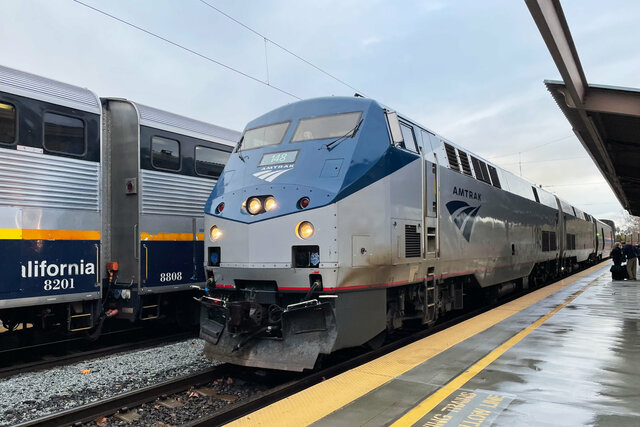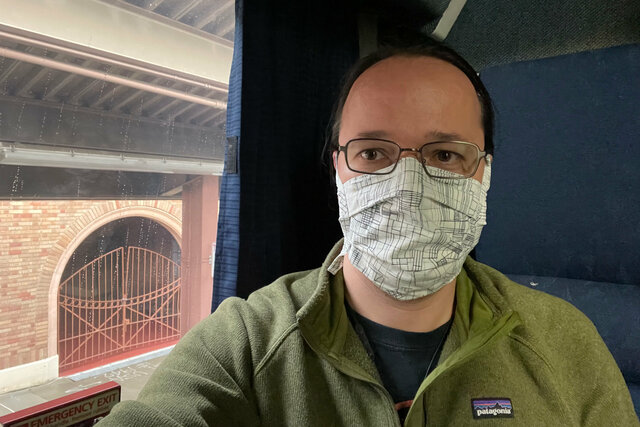Coast Starlight
Started: 2022-01-03 11:31:55
Submitted: 2022-01-03 14:10:02
Visibility: World-readable
Taking the (very delayed) train to Los Angeles
After visiting my parents in Walla Walla for Christmas, we still had a week off school and work before New Year's. I wanted to get out of the house and go somewhere (and I was worried that normal winter holiday destinations like skiing and Hawaii would be too crowded). We looked around for other ideas and thought about taking a train somewhere, as much for the trip itself as the destination. There's basically one long-distance passenger rail destination accessible from the greater Bay Area with kind-of-reasonable timing: Amtrak's Coast Starlight to Los Angeles.
By rail, San Jose to Los Angeles is 423 miles, and Amtrak's timetable schedules almost eleven hours for the trip. This is an average speed of less than 40 miles per hour, stopping at nine intermediate stations. From the timetable alone it's clear that the United States really doesn't care about passenger rail, otherwise we would have figured out how to invest in better infrastructure to support faster trains and schedule more trains per day. (California is currently working on an ambitious megaproject to build high-speed rail in the Central Valley, but maybe we should have worked simultaneously to upgrade the existing rail infrastructure to stimulate rail travel demand in the short term while also planning for the future.)
We booked train tickets to leave San Jose on Wednesday, 29th December; and return on Saturday, 1st January. We initially booked coach seats for the trip south and sleeper rooms for the trip north, then upgraded to sleeper rooms in both directions as a hedge against the fifth wave of the COVID-19 pandemic, driven by the Omicron variant.
The southbound sleeper room upgrade proved fortuitous by Tuesday evening, as we checked the train progress as it made its way south from Seattle and we discovered that the train was running five-and-a-half hours late. Amtrak thought the train would be able to make up time as it traveled south, so they estimated that it would only be five hours late in San Jose and three hours late in Los Angeles, but that still meant arriving at midnight, well past Julian's bedtime.
We took our time getting out of the house on Wednesday and driving across the mountain to San Jose in the light rain. It was unclear what the overnight parking situation at San Jose's Diridon station was; the station is owned and operated by Caltrain as a commuter rail hub traveling to San Francisco, so they don't expect overnight parking in their parking lots. Amtrak's page for the San Jose station mentioned vaguely that long-term parking was available, but it wasn't clear where this parking was or how we were supposed to use it, or if we were supposed to use the Spot Hero link to get a space. (Spot Hero did not list any spaces available for parking through New Year's.) I dropped Kiesa off at the front of the station so she could inquire about parking, and she emerged with a parking pass we could use at the small Amtrak long-term parking lot just south of the station building. (My backup plan was to drive to San Jose Airport and park there, then take a Lyft back to the station.)
We arrived at the station with plenty of time before our train arrived. Amtrak's forecast that the train could pick up several hours of time did not turn out to be true; the train finally pulled into the station at 15:55, five-and-a-half hours late.
We had two, two-person "roomette" cabins on the upper level of one of the the sleeper carriages. We were in rooms 17 and 19, next to each other on the same side of the train (facing left in the direction of travel, so we were generally on the east side of the south-bound train). The cabins were positioned on both sides of the train, along the corridor running down the center of the carriage, and had two seats facing each other next to a large window. The room had windows in the sliding door leading to the corridor, and in the wall next to the door, which could be covered with curtains (secured by Velcro) for more privacy.
With the door and the curtains closed we were in our own little private space, with a large window giving a view of whatever we could see outside the window.
Shortly after we rolled out of Diridon Station, the dining car steward came by to take our reservations for dinner. I watched the scenery roll by our window as we headed south, through suburban San Jose and onward towards Morgan Hill and Gilroy. Here, in suburban San Jose, according to the GPS app on my phone, we hit our maximum speed for the trip: 79 miles per hour, the fastest speed allowed by Federal railroad regulations before more safety requirements kicked in.
South of Gilroy the train turned to the west, nipped a corner of Santa Cruz County, and dropped into Monterey County, past a large gravel quarry along the Pajaro River next to the spot marked on my map as "Logan". I looked out my window just in time to see the train travel on a causeway through Elkhorn Slough, barely visible out my window at twilight.
The train climbed out of the slough and into the Salinas Valley. We made our first station stop in Salinas, then continued south next to US 101. The dining car called our reservations at 18:00, and we made our way down the train to eat supper. This was a sit-down table-service white-table-cloth dining experience with a small menu (there was only one vegetarian entree, tortellini), while we zipped through the Salinas Valley at 75 miles per hour. Outside the window I could see cars traveling on the highway at exactly the same speed. The best part of the meal was the tamale served as the first-course appetizer (though I ordered the salad instead, but helped eat Julian's tamale).
After dinner we returned to our rooms and considered the rest of the night. Soon the train climbed out of the Salinas Valley towards Cuesta Pass, providing dramatic views of US-101 across the canyon and below us, and of the train navigating the mountain curves and tunnels. If I looked ahead at the right time, I could see the engine on the curve ahead of us entering the tunnels on the hillside. Soon we descended towards San Luis Obispo on a long, serpentine track looping back on itself several times down the hillside into town.
We arrived in SLO around 21:00 and Calvin decided it was as good of a time as any to go to bed. The roomette sleeper was equipped with two beds: the upper bed folded down from the ceiling, and the daytime seats folded down into the lower bed. Calvin decided he wanted the upper bunk, so I prepared the upper bunk for him, including the straps providing some protection against rolling off the bunk when the train jostled and swayed in the middle of the night. I sat on the lower seat for another hour until I decided it was time to go to bed myself, hoping that I could get some sleep in the remaining four hours before our train pulled into Los Angeles.
I slept most of the rest of the way to Los Angeles, waking occasionally as the train pulled into stations announced over the PA. It was raining by the time we pulled into Los Angeles, and I could just make out the concrete channel of the Los Angeles River filled with water outside the train window.
We finally pulled into Los Angeles Union Station at 02:00, five hours late.
By the time we picked up our checked bag (on a baggage carousel looking just like a small-scale airport baggage carousel) and made our way to the front of the station (past people lounging in chairs in the the waiting room, and people who looked like they didn't have anywhere else to go) I requested a Lyft to take us to our hotel in downtown Los Angeles. We had four people, so I had to request a larger vehicle, and there were not many Lyft XL drivers out and about early on a rainy morning. We waited half an hour for our ride across downtown, while rain fell on a city that was clearly not used to this much rain.
At length we got a ride to our hotel, the historic Millennium Biltmore Hotel in downtown Los Angeles, and finally go to go to sleep in a stationary bed after 03:00.
Kiesa wrote a parallel account of our train ride to Los Angeles: Train Adventure: Part 1.










